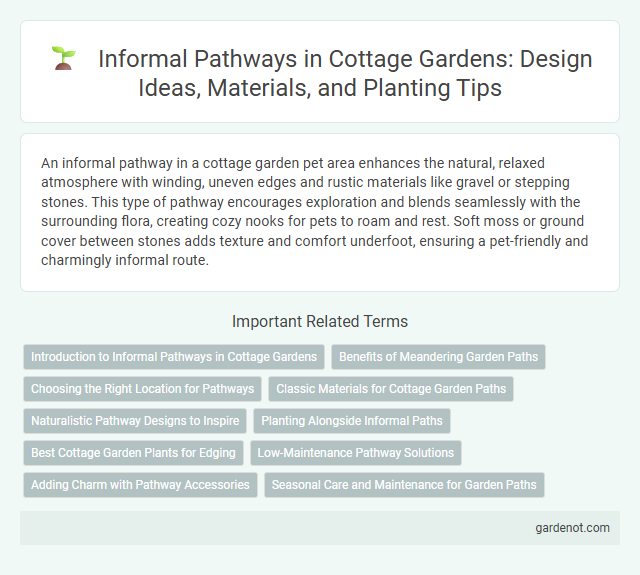An informal pathway in a cottage garden pet area enhances the natural, relaxed atmosphere with winding, uneven edges and rustic materials like gravel or stepping stones. This type of pathway encourages exploration and blends seamlessly with the surrounding flora, creating cozy nooks for pets to roam and rest. Soft moss or ground cover between stones adds texture and comfort underfoot, ensuring a pet-friendly and charmingly informal route.
Introduction to Informal Pathways in Cottage Gardens
Informal pathways in cottage gardens are designed to blend naturally with the surrounding planting, creating a relaxed and inviting atmosphere. These pathways often use materials like irregular stone, gravel, or mulch to enhance the garden's rustic charm and provide easy access without disrupting the organic layout. Their curving and asymmetrical shapes encourage exploration and complement the mixed borders of flowers, herbs, and shrubs typical of cottage garden aesthetics.
Benefits of Meandering Garden Paths
Meandering garden paths in a cottage garden create an informal, natural flow that enhances the overall aesthetic while encouraging leisurely exploration. These winding walkways increase the garden's perceived size by revealing different vistas and plant groupings gradually. Soft curves also reduce soil compaction by guiding foot traffic, promoting healthier plant growth along the edges.
Choosing the Right Location for Pathways
Selecting the right location for informal cottage garden pathways involves assessing natural foot traffic patterns and existing landscape features to create a seamless flow. Prioritize areas that connect key garden elements such as seating areas, flower beds, and entrances while maintaining organic shapes that complement the garden's relaxed aesthetic. Incorporating soft materials like mulch, gravel, or stepping stones enhances the informal feel while ensuring durability and comfort.
Classic Materials for Cottage Garden Paths
Classic materials for cottage garden paths include natural stone, brick, and gravel, which complement the informal, relaxed style of the garden. Flagstones create irregular, organic shapes that enhance the rustic charm, while aged bricks laid in simple patterns offer durability and visual warmth. Gravel paths provide excellent drainage and a soft crunch underfoot, reinforcing the casual, inviting atmosphere typical of cottage gardens.
Naturalistic Pathway Designs to Inspire
Naturalistic pathway designs in cottage gardens emphasize informal, meandering routes that blend seamlessly with lush plantings and rustic materials like crushed stone, bark, or brick. These pathways encourage exploration and create a relaxed atmosphere by mimicking natural landscapes with irregular shapes and soft edges. Incorporating native plants along the edges enhances biodiversity and enriches the sensory experience, making each stroll unique and immersive.
Planting Alongside Informal Paths
Planting alongside informal pathways in a cottage garden enhances its whimsical charm by featuring mixed borders of perennials, herbs, and flowering shrubs such as lavender, foxglove, and catmint. These plants soften the edges of gravel or stone paths, creating a natural flow that invites exploration and blends seamlessly with the garden's relaxed design. Incorporating low-growing groundcovers like creeping thyme or chamomile adds texture and fragrance, enriching the sensory experience along the winding route.
Best Cottage Garden Plants for Edging
Informal pathways in cottage gardens are beautifully defined by best cottage garden plants for edging such as lavender, foxglove, and creeping thyme, which provide a natural, inviting border while enhancing fragrance and color. These plants thrive in well-drained soil and partial to full sun, offering seasonal blooms that attract pollinators and add texture along winding paths. Selecting drought-tolerant varieties like sedum or hardy geranium ensures low maintenance and year-round appeal, perfect for maintaining the casual charm of an informal cottage garden pathway.
Low-Maintenance Pathway Solutions
Informal pathways in cottage gardens often utilize low-maintenance materials such as gravel, mulch, or stepping stones to create natural, charming routes that blend seamlessly with surrounding plants. These materials allow for good drainage, reduce weed growth, and require minimal upkeep compared to paved options. Incorporating native ground covers alongside pathways further minimizes maintenance while enhancing the garden's rustic aesthetic.
Adding Charm with Pathway Accessories
Informal pathways in cottage gardens create a natural, inviting flow that enhances the garden's rustic charm. Incorporating pathway accessories such as weathered lanterns, charming stepping stones, and whimsical garden stakes adds personalized character and visual interest. These elements not only guide visitors but also complement the lush, organic plantings typical of cottage gardens.
Seasonal Care and Maintenance for Garden Paths
Seasonal care and maintenance for informal cottage garden pathways include regular clearing of debris and repairing uneven surfaces to prevent trip hazards and maintain aesthetic appeal. Applying mulch or gravel in spring helps with weed control and moisture retention while enhancing natural drainage during rainy seasons. Autumn requires the removal of fallen leaves and monitoring for erosion to preserve the path's integrity throughout winter.
Informal pathway Infographic

 gardenot.com
gardenot.com